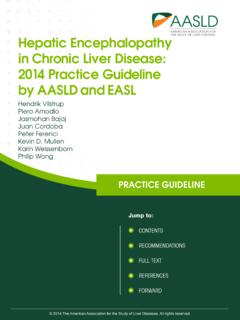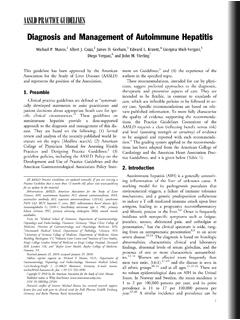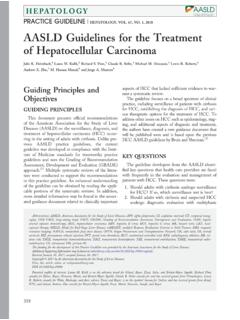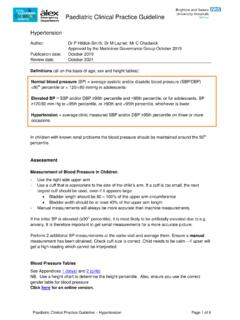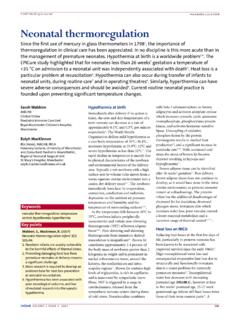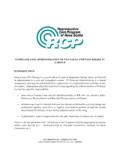Transcription of Diagnosis and treatment of Wilson disease: An update - …
1 AASLD PRACTICE GUIDELINESD iagnosis and treatment of Wilson disease :An UpdateEve A. Roberts1and Michael L. Schilsky2 This guideline has been approved by the American Asso-ciation for the Study of Liver Diseases (AASLD) and rep-resents the position of the recommendations provide a data-supported ap-proach to the Diagnosis and treatment of patients withWilson disease . They are based on the following: (1) for-mal review and analysis of the recently-published worldliterature on the topic including Medline search; (2)American College of Physicians Manual for AssessingHealth Practices and Designing Practice Guidelines1; (3)guideline policies, including the AASLD Policy on theDevelopment and Use of Practice Guidelines and theAmerican Gastroenterological Association Policy State-ment on Guidelines2; (4) the experience of the authors inthe specified topic.
2 A significant problem with the litera-ture on Wilson disease is that patients are sufficiently rareto preclude large cohort studies or randomized controlledtrials; moreover, most treatment modalities were devel-oped at a time when conventions for drug assessment wereless stringent than at for use by physicians, these recommenda-tions suggest preferred approaches to the diagnostic, ther-apeutic, and preventive aspects of care. They are intendedto be flexible, in contrast to standards of care, which areinflexible policies to be followed in every case. Specificrecommendations are based on relevant published infor-mation. To characterize more fully the quality of evidencesupporting recommendations, the Practice GuidelinesCommittee of the AASLD requires aclass(reflecting ben-efit versus risk) andlevel(assessing strength or certainty)of evidence to be assigned and reported with each recom-mendation (Table 1, adapted from the American Collegeof Cardiology and the American Heart Association Prac-tice Guidelines3,4).
3 IntroductionCopper is an essential metal that is an important cofac-tor for many proteins. The average diet provides substan-tial amounts of copper, typically 2-5 mg/day; therecommended intake is mg/day. Most dietary copperends up being excreted. Copper is absorbed by entero-cytes mainly in the duodenum and proximal small intes-tine and transported in the portal circulation inassociation with albumin and the amino acid histidine tothe liver, where it is avidly removed from the liver utilizes some copper for metabolic needs, syn-thesizes and secretes the copper-containing protein ceru-loplasmin, and excretes excess copper into bile. Processesthat impair biliary copper excretion can lead to increasesin hepatic copper disease (WD; also known as hepatolenticulardegeneration) was first described in 1912 by Kinnear Wil-son as progressive lenticular degeneration, a familial,lethal neurological disease accompanied by chronic liverdisease leading to the next several de-cades, the role of copper in the pathogenesis of WD wasestablished, and the pattern of inheritance was deter-mined to be autosomal ,7In 1993, the abnormalgene in WD was gene,ATP7B, en-codes a metal-transporting P-type adenosine triphos-phatase (ATPase), which is expressed mainly inhepatocytes and functions in the transmembrane trans-port of copper within hepatocytes.
4 Absent or reducedfunction of ATP7B protein leads to decreased hepatocel-lular excretion of copper into bile. This results in hepaticcopper accumulation and injury. Eventually, copper isreleased into the bloodstream and deposited in other or-gans, notably the brain, kidneys, and cornea. Failure toincorporate copper into ceruloplasmin is an additionalconsequence of the loss of functional ATP7B hepatic production and secretion of the ceruloplas-Abbreviations: AASLD, American Association for the Study of Liver Diseases;BAL, British anti-Lewisite; MR, magnetic resonance; TM, tetrathiomolybdate;WD, Wilson the1 Division of Gastroenterology, Hepatology and Nutrition, The Hospitalfor Sick Children, and Departments of Paediatrics, Medicine and Pharmacology,University of Toronto, Toronto, Ontario, Canada, and2 Department of Medicineand Surgery, Division of Digestive Diseases, Section of Transplant and Immunol-ogy, Yale University Medical Center, New Haven, 2008 by the American Association for the Study of Liver online in Wiley InterScience ( ).
5 DOI conflict of interest: Nothing to protein without copper, apoceruloplasmin, result inthe decreased blood level of ceruloplasmin found in mostpatients with WD due to the reduced half-life of occurs worldwide with an average prevalence of 30 affected individuals per million canpresent clinically as liver disease , as a progressive neuro-logical disorder (hepatic dysfunction being less apparentor occasionally absent), or as psychiatric illness. WD pre-sents with liver disease more often in children andyounger adult patients than in older adults. Symptoms atany age are frequently was uniformly fatal until treatments were devel-oped a half-century ago. WD was one of the first liverdiseases for which effective pharmacologic treatment wasidentified. The first chelating agent introduced in 1951for the treatment of WD was British anti-Lewisite (BALor dimercaptopropanol).
6 13,14 The identification and test-ing of an orally administered chelator,D-penicillamine,by John Walsh in 1956 revolutionized treatment of treatment modalities have since beenintroduced, including zinc salts to block enteral copperabsorption, tetrathiomolybdate (TM) to chelate copperand block enteral absorption, and orthotopic liver trans-plantation, which may be lifesaving and curative for FeaturesOver the years, diagnostic advances have enabled moresystematic evaluation of individuals suspected to haveWD prior to their development of neurologic include recognition of corneal Kayser-Fleischerrings,16identification of reduced concentrations of ceru-loplasmin in the circulation of most patients,17and theability to measure copper concentration in percutaneousliver biopsy specimens.
7 More recently, molecular diag-nostic studies have made it feasible either to define pat-terns of haplotypes or polymorphisms of DNAsurroundingATP7 Bwhich are useful for identification offirst-degree relatives of newly diagnosed patients or toexamine directly for disease -specificATP7 Bmutations onboth alleles of chromosome with cirrhosis, neurological manifestations,and Kayser-Fleischer rings are easily diagnosed as havingWD because they resemble the original clinical descrip-tion. The patient presenting with liver disease , who is atleast 5 years old but under 40 years old, with a decreasedserum ceruloplasmin and detectable Kayser-Fleischerrings, has been generally regarded as having classic , about half of the patients presenting with liverdisease do not possess two of these three criteria and posea challenge in trying to establish the , as with other liver diseases, patients may come tomedical attention when their clinical disease is compara-tively at present,de novogenetic Diagnosis is expen-sive and not universally available (and sometimes incon-clusive), a combination of clinical findings andbiochemical testing is usually necessary to establish thediagnosis of WD (Fig.)
8 1). A scoring system has been de-vised to aid Diagnosis , based on a composite of key param-eters20; it has been subjected to preliminary validation molecular genetic strategy using haplotypeanalysis or direct mutation analysis may be effective inidentifying affected siblings of of spectrum of liver diseaseencountered in patients with WD is summarized in Table2. The type of the liver disease can be highly variable,ranging from asymptomatic with only biochemical ab-normalities to acute liver failure. Children may be entirelyasymptomatic, with hepatic enlargement or abnormal se-rum aminotransferases found only incidentally. Some pa-tients have a brief clinical illness resembling an acute viralhepatitis, and others may present with features indistin-guishable from autoimmune hepatitis.
9 Some present withonly biochemical abnormalities or histologic findings ofsteatosis on liver biopsy. Many patients present with signsof chronic liver disease and evidence of cirrhosis, eithercompensated or decompensated. Patients may presentwith isolated splenomegaly due to clinically inapparentcirrhosis with portal hypertension. WD may also presentas acute liver failure with an associated Coombs-negativehemolytic anemia and acute renal failure. Some patientsTable 1. Grading System for RecommendationsClassificationDescription Class IConditions for which there is evidence and/or generalagreement that a given procedure or treatment isbeneficial, useful, and IIConditions for which there is conflicting evidence and/ora divergence of opinion about the usefulness/efficacyof a procedure or IIaWeight of evidence/opinion is in favor of IIbUsefulness/efficacy is less well established IIIC onditions for which there is evidence and/or generalagreement that a procedure/ treatment is not useful/effective and in some cases may be of EvidenceDescriptionLevel AData derived from multiple randomized clinical trials BData derived from a single randomized trial, ornonrandomized COnly consensus opinion of experts, case studies.
10 ROBERTS AND SCHILSKYHEPATOLOGY, June 2008have transient episodes of jaundice due to hemolysis may be associated with WD whenliver disease is not clinically evident. In one series, hemo-lysis was a presenting feature in 25 of 220 cases (11%); inthese patients, hemolysis occurred as a single acute epi-sode, recurrently, or was low-grade and aseries of 283 Japanese cases of WD, only three presentedwith acute hemolysis alone,23but one-quarter of the pa-tients who presented with jaundice also had diagnosed with WD who have a history of jaun-dice may have previously experienced an episode of with apparent autoimmune hepatitis present-ing in childhood, or in adults with a suspicion of autoim-mune hepatitis that does not readily respond to therapy,should be assessed carefully for WD because elevated se-rum immunoglobulins and detectable nonspecific auto-antibodies may be found in both manifestations of WD typically present laterthan the liver disease , most often in the third decade of life.


